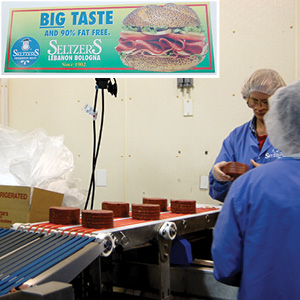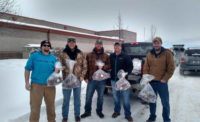The deli meat category is by nature a user-friendly product, and many varieties are marketed to give consumers just the right slice. Thick-sliced, thin-sliced, shaved, “carving board” — they exist to provide the shopper with the convenience needed to make a quick sandwich.

|
That need for convenience puts an emphasis on having a reliable slicer, one that is versatile enough to slice to a variety of widths and consistent enough to ensure each package of deli meat is filled with uniform, quality product.
The need for a reliable slicer extends past the makers of ham, roast beef and turkey deli meats, and extends to the specialty deli processors. Seltzer’s Smokehouse, located in Palmyra, Pa., produces Lebanon bologna in its traditional, two-story wood smokehouses. Ron Fouché, manager, says that Lebanon bologna can be a difficult product to slice.
“You need to have a nice, clean blade,” he says. “It’s not a cooked product, so it slices a little bit harder. It’s also a heavy meat product — in other words, it’s 90 percent fat-free, so you have a lot of meat to slice through, unlike a fatty product that is much easier to go through.”
While Seltzer’s does not have as varied a product line as other processors, it does require a slicer with some versatility to accommodate its product line. The company produces its varieties of bologna, including Lebanon bologna, sweet Lebanon bologna, and double-smoked Lebanon bologna, in several different-size packages and thicknesses. The company has 8-ounce, 12-ounce and 16-ounce flexible packages, as well as a semi-rigid 6-ounce package.
“We want to be able to slice thicknesses from 28 to 30 a pound to as few as 20 to 22 a pound,” Fouché states.
The bologna comes out of the smokehouses in 52-inch logs and is transferred to coolers to chill the logs to 28 degrees, says Jack McCaffery, maintenance manager. The casings are then stripped off, and the bologna is loaded onto the slicer.
“It slices two loaves at a time and runs a maximum of 1,500 slices a minute,” says McCaffery. “It comes off the slicer, and the slicer has a scale that rejects any underweights or overweights.”
An employee is on hand to add slices to the underweight portions or remove from the overweight ones, and from there, the bologna moves on to the packaging equipment.
McCaffery says that Seltzer’s previous slicer was a hydraulic model, which he described as a “nightmare” for maintenance. The present machine uses stepper motors, which was a significant upgrade.
“The new slicer is a dream. There’s very little maintenance with this machine at all,” he says.





Report Abusive Comment